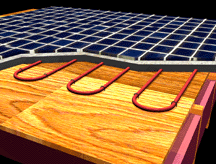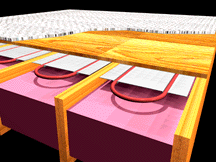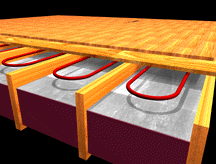Types of Radiant Heating Installations
Radiant heating systems can be installed in a number of different configurations and can be designed into a variety of new construction and retrofit environments.
Information on this page
reprinted by permission of:


Concrete Slab
Tubing is attached to wire mesh or fixtures to hold them in place until the concrete floor is poured. The tubing or elements are embedded in the concrete anywhere from the bottom of the slab to within 2 inches of the surface, depending on the design and installation technique.

Thin Slab
Tubing is attached to the wood subfloor with fastners to hold them in place until a concrete, lightweight concrete, dry pack or gypsum underlayment is installed as the final subfloor. Gypsum products bond to the subfloor and are generally thinner and lighter than concrete products. Concrete must be separated from the subfloor with a slip sheet to prevent bonding. The subfloor structure must be built to minimize flexing to avoid cracking the slab.

Modular Radiant Underlayment
Premanufactured modular boards with a laminated layer of aluminum and a channel to accept radiant tubing are screwed or nailed to the subfloor. Hardwood floors can be nailed directly to the radiant underlayment or carpet and pad placed over the radiant underlayment. It is also possible to nail a second subfloor over the plates for a smoother finish for vinyl areas. A cement board is used when tile or stone is to be installed.

Conductive Aluminum Plates
Tubing is attached to the underside of the existing subfloor. Aluminum plates are used to spread the heat evenly under the subfloor. Insulation is placed in the joist space beneath the tubing. A two-inch air space is usually left between the insulation and the bottom of the subfloor. Care must be taken when nailing any floor covering from above.

Hanging in Joist Space
Tubing is suspended several inches beneath the subfloor in the joist space. Insulation is installed in the joist space beneath the tube with a 2 to 4 inch air space between the top of the insulation and the bottom of the subfloor. The air within this space is heated by the tube which, in turn, heats the underside of the subfloor. This type of installation is not generally recommended, due to limited heat output.